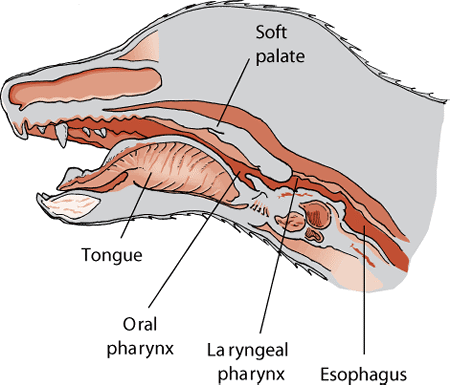Disorders of the Pharynx (Throat) in Dogs
- Digestive Disorders of Dogs
- Introduction to Digestive Disorders of Dogs
- Congenital and Inherited Disorders of the Digestive System of Dogs
- Dental Development of Dogs
- Dental Disorders of Dogs
- Disorders of the Mouth in Dogs
- Disorders of the Pharynx (Throat) in Dogs
- Disorders of the Esophagus in Dogs
- Vomiting in Dogs
- Disorders of the Stomach and Intestines in Dogs
- Disorders Caused by Bacteria in the Digestive System of Dogs
- Gastrointestinal Parasites of Dogs
- Disorders Caused by Protozoa in the Digestive System of Dogs
- Pancreatitis and Other Disorders of the Pancreas in Dogs
- Disorders of the Liver and Gallbladder in Dogs
- Disorders of the Rectum and Anus in Dogs
Also see professional content regarding pharyngeal paralysis.
The upper throat is called the pharynx. Pharyngeal paralysis refers to paralysis of the upper throat (pharynx) that makes swallowing difficult or impossible. It may be caused by a nervous system disorder or other disease or trauma that causes collapse, obstruction, or malfunction of the pharynx. In some instances, the condition may be partial or affect only one side of the throat and the dog may be able to swallow, although complications may occur.
Pharyngeal paralysis results in severe problems with swallowing; food and saliva come back out through the mouth and nose. In most species, collapse of throat tissues occurs. Affected dogs are at risk of pneumonia from inhaling food and liquid (aspiration pneumonia), dehydration, and circulatory and respiratory failure. Signs of pharyngeal paralysis include fever, coughing, gagging, and choking. This condition may be fatal. In many cases, emergency surgery to provide an airway (tracheos-tomy) must be done before any more detailed analysis of the condition can be performed.
In general, treatment for pharyngeal paralysis is directed toward alleviating the signs of the disease. Treatment may include drugs to control inflammation, antibiotics to control the complications of aspiration pneumonia, draining of abscesses (if they are present), and alternative routes of nutrition. Tubes can be inserted (intubation) to help the dog breathe, eat, and drink. In many of these cases, the outlook is poor. Your veterinarian will consider the welfare of your pet when determining what course of treatment to follow.
For More Information
Also see professional content regarding pharyngeal paralysis.
Resources In This Article
- Digestive Disorders of Dogs
- Introduction to Digestive Disorders of Dogs
- Congenital and Inherited Disorders of the Digestive System of Dogs
- Dental Development of Dogs
- Dental Disorders of Dogs
- Disorders of the Mouth in Dogs
- Disorders of the Pharynx (Throat) in Dogs
- Disorders of the Esophagus in Dogs
- Vomiting in Dogs
- Disorders of the Stomach and Intestines in Dogs
- Disorders Caused by Bacteria in the Digestive System of Dogs
- Gastrointestinal Parasites of Dogs
- Disorders Caused by Protozoa in the Digestive System of Dogs
- Pancreatitis and Other Disorders of the Pancreas in Dogs
- Disorders of the Liver and Gallbladder in Dogs
- Disorders of the Rectum and Anus in Dogs







